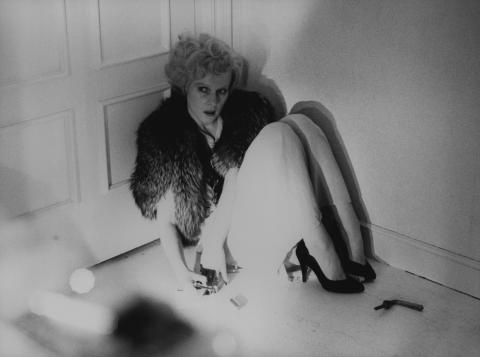Pure Monochrome: VERONIKA VOSS

VERONIKA VOSS
These notes on Rainer Werner Fassbinder's Veronika Voss (1982) were written by Tim Brayton, PhD candidate in the Department of Communication Arts at UW Madison. A 35mm print of Veronika Voss will screen on on Sunday, December 16, 2018 at 2 p.m. at the Chazen Museum of Art, a screening that will conclude our Fassbinder series and our 2018 programming.
By Tim Brayton
It’s not difficult to see why Veronika Voss might inspire such passion. More than most of Fassbinder’s films, it offers no ironic detachment from its own artistry; it openly demands respect and admiration, showcasing some of the most complex imagery in the director’s career. It also presents one of his most serious and mirthless visions of human suffering. While one might reasonably wonder what has happened to the light, sardonic camp of his great melodramas, this is no mere wallow in human misery. Rather, Veronika Voss is a work of profound empathy, a gesture of kindness from one drug user spiraling out of control to another (when Fassbinder died, less than four months after the film’s premiere, it was of an accidental overdose).
The story was inspired by the post-war career and death of Sybille Schmitz, one of Fassbinder’s favorite movie stars. Despite her success in the 1930s, her reputation suffered a fatal blow thanks to her willing collaboration with the Third Reich filmmakers of the state-run UFA film studio. By the mid-’50s, she was a ghost, filling the gaps between rare supporting roles with alcohol and drugs supplied by the shady Dr. Ursula Moritz. The sordid tale of Schmitz’s degraded life in 1955, and the black market criminality of Moritz’s alleged morphine ring, made for a perfect melodramatic crime scenario, though in the end, Veronika Voss (with names changed and details smudged to avoid legal repercussions), is not at all the sort of film that the phrase “crime melodrama” calls to mind.
It is, rather, a bleak but loving character study of Schmitz/Voss as made by one of the world’s great cinephile-directors. If there’s anything that connects Veronika Voss with the rest of Fassbinder’s prodigious output, it’s the rich sense of cinema history he brings to the proceedings. This time, the warm colors and fulsome emotions of his Sirkian melodramas is abandoned for the black-and-white of German Expression or its little American sibling, film noir; though only rarely even in the high-contrast chiaroscuro of noir do we find a film so austere in its palette as this. To call a film “black-and-white” generally implies that there will be some greys, too, but Fassbinder and cinematographer Xaver Schwarzenberger have very little interest in such nuance: Veronika Voss is a film of pure monochrome, made up of little else than layered slashes of deepest blacks and harshest whites. The hospital run by the corrupt Dr. Marianne Katz (Annemarie Düringer) is one of the all-time great cinematic asylums, made entirely from featureless slabs of sterile white, glowing with inhuman malevolence as they crush in against poor Veronika (Rosel Zech).
Even outside of the walls of this institution, the dominate visual scheme of the film is of imprisonment. The filmmakers use precise compositions, dominated by straight lines and geometric forms, to pin Veronika into tiny spaces, paradoxically using deep compositions to emphasize how little room she has to maneuver. Even in the happiest memory we’ll ever see, when she recalls the shooting of one of her many successful movies of yesteryear, the image is dominated by huge, star-shaped lens flares (the film used special lenses to exaggerate these and other flares), which form an impenetrable grid of diagonal lines that present Veronika almost literally as an inmate behind bars, caged by the film industry that will shortly view her as a disreputable memory to be buried and forgotten.
Like the other two protagonists of Fassbinder’s BRD trilogy, Hanny Schygulla’s Maria Braun and Barbara Sukowa’s Lola, Veronika stands in as a symbol for a particular form of West German life in the decade following World War II. But while her predecessors are hard-edged survivors, Veronika is a victim and a scapegoat, an emblematic “Bad” German who can be burdened with all the sins of West Germany’s Nazi past, thereby freeing all the “Good” Germans from having to seriously reckon with their recent behavior. Rosel Zech captures all of the terror and despair of being caught in this position, bringing Veronika to life with an array of facial expressions so frightened and needful that it’s almost painful to watch. The film’s German title translates as The Longing of Veronika Voss, and “longing” is plastered over every inch of Zech’s performance: longing for comfort, for understanding, for a place in a world that turned on her for cruel and selfish reasons.
It is bleaker, sadder, and angrier than most Fassbinder films, but tinged with sympathy. Veronika and the invented character Robert Krohn (Hilmar Thate), a married investigative journalist who falls desperately in love with her, agonized by his inability to save her (he’s an obvious stand-in for Fassbinder himself) are both pathetic in the fullest sense of the word. That is, they are hapless and hampered by their own misjudgments, but also – and far more importantly – they are imbued by their director with great pathos. In looking at Veronika, Fassbinder clearly sees a woman who did terrible things during the war, but is now being martyred by people who also did terrible things during the war. She is the victim of mid-century Germany’s anxious desire to boost its economy, to indiscriminately devour American culture as a ward against too much German-ness (the corny 1959 Johnny Horton country hit “The Ballad of New Orleans” anachronistically appears as a tragic leitmotif), and she is a powerful anchor to Fassbinder’s last and most lacerating attack on the corrupt modern history of his country.
